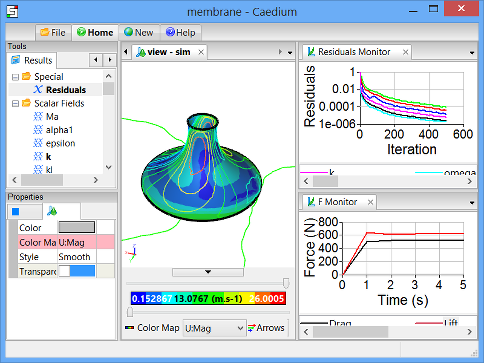
12 CFD Tips for a Productive New Year
Submitted by Richard Smith on January 6, 2014 - 08:19
To make best use of Computational Fluid Dynamics (CFD) software there are a number of key concepts to keep in mind. Based on my experiences and those of Caedium Professional users here's a selection of the important issues to consider while you prepare and perform your own CFD simulations.
 Caedium Professional CFD Simulation
Caedium Professional CFD Simulation
CFD Tips
- Ensure you understand the fluid mechanics that applies to your specific application. If you know what to expect from a CFD simulation it makes it much easier to validate the final CFD results.
- If you are not familiar with a particular CFD tool then work through some tutorials before you try to simulate your application to get a better idea of how a particular CFD tool operates.
- Keep your CFD simulations as simple as possible in terms of geometry and physics. Add details (complexity) incrementally and avoid detailed CAD assembly dumps with manufacturing details such as fasteners.
- Create your CFD geometry in a CAD system that uses analytic representations (e.g., NURBS), especially if your model contains curved surfaces. Using analytic surfaces ensures that your CFD simulations will accurately mimic your geometry.
- Sequence your CFD preparation according to geometry, surface mesh, volume mesh, physics assignment, and post processing. Each step relies on the previous step, so if you skip directly to the volume mesh only to find you need to modify your surface mesh or geometry you will waste valuable time.
- Create a residual monitor and a variable monitor (e.g., lift, drag, average pressure) to help determine whether your steady-state simulation has converged, indicated by at least a drop of 3 orders of magnitude in all residuals.
- Remember that for a steady-state simulation the intermediate results on its progression to convergence are not physically valid, even if they sometimes look plausible.
- Explore various CFD parameters (e.g., mesh accuracy, boundary conditions, outer boundary distances, symmetry) to ensure you simulate the correct scenario and make best use of your available time and computing resources.
- Postpone creation of resource intensive visualization (e.g., iso-surfaces, streamlines) until the end of the simulation to free up resources (i.e., CPU cycles and memory) for the solve cycle and minimize the overall turnaround time.
- Validate your CFD results against other results, e.g., hand calculations, experiments, other CFD results. Without validation how do you know that your CFD results are valid and you haven't made a mistake?
- For external CFD simulations you often need to construct a volume around your object, which means you need to subtract your object from a larger volume representing the outer boundary. This is analogous to the mold you would create to manufacture a casting of your object.
- Ensure that your open boundaries (e,g., inlet, outlet, far field, free stream) are far enough away from your geometry of interest so as not to influence the results. Ideally such boundaries should be in regions free of pressure and velocity variation (gradients). Outlets should avoid straddling recirculation zones.
Resources
- For more on fluid mechanics and CFD see "CFD Novice to Expert Reloaded".
- Diagnose problems with your CFD simulations using "How do I fix mesh and solver failures?".
Have a productive New Year.
Recent blog posts
- CFD Simulates Distant Past
- Background on the Caedium v6.0 Release
- Long-Necked Dinosaurs Succumb To CFD
- CFD Provides Insight Into Mystery Fossils
- Wind Turbine Design According to Insects
- Runners Discover Drafting
- Wind Tunnel and CFD Reveal Best Cycling Tuck
- Active Aerodynamics on the Lamborghini Huracán Performante
- Fluidic Logic
- Stonehenge Vortex Revealed as April Fools' Day Distortion Field
